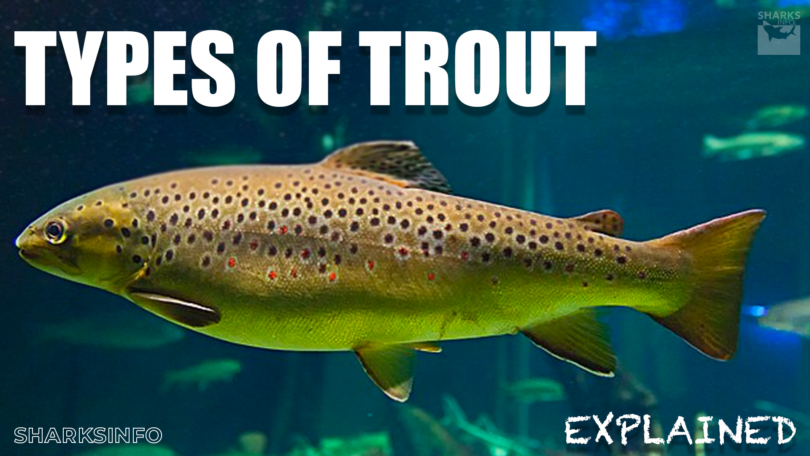Trout is a popular fish among anglers and seafood lovers. It consists of a group of ray-finned fish species belonging to the family Salmonidae and the subfamily Salmoninae. They are popular freshwater carnivorous species of the same shape. The Trout mostly dwell in freshwater lakes, rivers, and seas, and migrate to shallow water streams between spawning. The color of the species of the Trout group depends on the area in which they live.
Are you wondering about Trout? How many types of Trout species are there? Read this guide to learn about the unique features of different types of Trout.
Scientific Classification of Trout
Trouts are fish and based on their characteristics, they are classified as follows:
Phylum: Chordata
Class: Actinopterygii
Family: Salmonidae
Genus: Salmo, Oncorhynchus, Salvelinus
What is Trout?
Trout are the sport fishes that are smaller than Salmon. These species are restricted to cold and clear freshwater. But some species like Rainbow Trout spend some time of their life in the oceans. These species dwell in the sea but return to the river to lay eggs. Most of the species of Trout belong to the Genera of Salmo, Oncorhynchus, and Salvelinus. The members of different genera can be distinguished by the color of their bodies, the teeth, and the shape of the vomers; the vomer are the bones forming the anterior part of the roof of the mouth.
The Trout has a long oval body, small eyes, and a mouth with dark silvery scales on the side. It also has colorful spots on the dorsal fin. They can grow up to the average size of 2 feet.
The Trout is the favorite food source for humans, eagles, and polar bears as it is a delicious and nutrient-rich fish. These carnivore species feed on other aquatic animals including Mollusks, worms, shrimps, and snails.
Types of Trout | Explained
There are over 50 species of Trout belonging to one of three genera. We have listed the Trout depending on the genus they belong:
1: Trout in Genus Salmo
- Adriatic Trout
- Brown Trout
- Flathead Trout
- Marble Trout
- Ohrid Trout
- Sevan Trout
- Palomino Trout
1.1: Adriatic Trout
The Adriatic Trout is an important freshwater game fish. They are the most sought-after species which are hunted by anglers to have fun and pleasure.
Scientific Name: Salmo obtusirostris.
Appearance: Adriatic Trout is a green-colored Trout with red and black spots all over the body. The Trout has no vertical stripes that are common in the other Trout of the Adriatic drainage. This Trout has a small and fleshy mouth and an elongated tail.
Size: They can grow up to the length of 70 cm.
Life Span: They can live up to 7 years.
Habitat: These Trout live in freshwater as well as salt water. They are mostly found in water at high altitudes, usually in deep and quiet places.
Diet: They feed on other insects and small fish.

1.2: Brown Trout
The Brown Trout is the most valuable, clever, and least attractive exotic species of Trout. They can be found on every continent except Antarctica.
Scientific Name: Salmo trutta.
Appearance: The dorsal part of the fish is olive-brown while the ventral side is yellow in color. It has black and olive spots on the sides of their bodies. The underside of their bodies is white. The pectoral, anal, and pelvic fins have white margins.
Size: The average size of brown Trout is 7 to 14 inches.
Life Span: The lifespan of Brown Trout depends on the habitat. They can live an average of five years.
Habitat: Brown Trout can be found in rivers, lakes, large ponds, and cold-water streams. They are more tolerant of warm waters compared to other Trout. They love to hang out in hidden places like around trees and rocks.
Diet: They prey on Crayfish, Mollusks, frogs, and other small mammals.

1.3: Marble Trout
Marble Trout is the indigenous species in the western part of the Slovenia river system.
Scientific Name: Salmo trutta marmoratous.
Appearance: They have cylindrical long lean bodies with large heads and sharp teeth. The male can be differentiated from the female Marble Trout based on the lower jaw. The lower jaw in males is directed downwards and in females the lower jaw is straight. They have a dominant olive-green color over black over the top and green mixes with light black at the lower side of their bodies.
Size: They can grow up to 51 inches.
Life Span: They can live up to 8 years.
Habitat: They live in fast-flowing waters and lakes.
Diet: The diet of the Marble Trout changes with age, the smaller Trout feeds on nymphs and plants and once they get bigger, they prey on other smaller fishes.

1.4: Ohrid Trout
The Ohrid Trout is the endemic species of lake Ohrid and its nearby places. It is one of the oldest Trout in the world, around 3 million years ago.
Scientific Name: Salmo letnica.
Appearance: It has a silvery-colored body with green eyes. They have black spots above the dorsal region and red spots on the lateral region. The various spots on the caudal fin make it different from the Brown Trout.
Size: These Trout have the ability to grow up to 6 cm.
Life Span: The average Ohrid Trout lives 7 years.
Habitat: You can only find the Ohrid Trout in the lake Ohrid; this lake has crystal clear water, and you can easily see the bottom even if it is 10cm deep. These Trout live in a depth of 60 to 80 cm in the lake. Apart from Ohrid, the only other place where you can find Ohrid species is Baikal.
Diet: They mostly prey on other fish and zooplankton.

1.5: Sevan Trout
The Sevan Trout known for its distinctive appearance is the endemic species of Lake Sevan in Armenia. Armenia is one of the largest freshwaters and second highest-elevation lakes in the world. This species of Trout plays an important role in maintaining a balanced ecosystem by regulating the smaller fishes.
Scientific Name: Salmo Ischchan.
Appearance: The Trout changes its colors depending on nutrition and the climate. They have a silvery body with a hump on its back. During the spawning, the male sevan becomes darker and their fins become black with red spots around their bodies.
Size: They can grow up to 50 to 60 cm.
Life Span: They can live up to 7 years.
Habitat: They mostly dwell in the Sevan lake in Armenia.
Diet: They feed on plankton and benthos; the benthos is the community of organisms that live near or in the bottom of the lake.

1.6: Palomino Trout
The Palomino Trout is also known as the Golden Rainbow Trout. It lives in the cold water of the Pacific Ocean and Great Lakes.
Scientific Name: Oncorhynchus mykiss.
Appearance: The Palomino Trout have deep yellow-gold-colored bodies with pink cheeks and fins. They are marked with the lateral red stripe common in all rainbow Trout. There are no spots on their bodies and fins.
Size: They have the capacity to grow up to 12 to 30 inches.
Life Span: The typical lifespan of Palomino Trout is three to five years.
Habitat: They are freshwater species meaning they prefer rivers, streams, and creeks to live.
Diet: The Palomino Trout are carnivores, and they eat insects, small crustaceans, and other small fishes.

2: Trouts in Genus Oncorhynchus
- Cutthroat Trout
- Apache Trout
- Gila Trout
- Rainbow Trout
- Biwa Trout
- Eagle Lake Trout
- Golden Trout
2.1: Cutthroat Trout
The Cutthroat Trout is the species that has derived its name from the red color around its lower jaw. It is the first recorded Trout species in North America. The Cutthroat is a popular fish among anglers who enjoy flying fish.
Scientific Name: Oncorhynchus clarkii.
Appearance: The young Cutthroat is yellowish in color with red or pink spots around the lateral line and gills cover. The adult is golden yellow with black spots around the head and fins.
Size: They are generally 6 to 6 cm long.
Life Span: They can live over 12 years.
Habitat: They live in the upstream fresh, well-oxygenated, and cold water of the Pacific Ocean, Great Basin, and Rocky Mountains. They are more sensitive to the quality of water than other Trout.
Diet: They mostly feed on gastropods, fish, insects, and amphipods.

2.2: Apache Trout
The Apache Trout is one of the only Trout natives to Arizona.
Scientific Name: Oncorhynchus apache.
Appearance: They are yellowish gold with gold belly and small black spots all over the body that are evenly spaced. The head of the Apache Trout is the most distinguishing feature of them. They have an octopus-like circular shape with dark eyes. You can also identify this species from the line that is running along the lateral side of their bodies.
Size: They are 6 to 24 inches long.
Life Span: The average lifespan of Apache Trout is five years. The maximum ability to live the Apache Trout is 9 years.
Habitat: It is the state fish of Arizona that lives in the cold and fresh water of the White Mountains and streams.
Diet: They feed on aquatic and terrestrial animals.

2.3: Gila Trout
Gila Trout is one of the rarest Trout species in the USA and is the first species that was protected under ESA. The name of the Gila Trout is given on the basis of the location they live in.
Scientific Name: Oncorhynchus gilae.
Appearance: They have yellowish-brown, gold, and copper bodies with numerous black spots on the upper half of their bodies.
Size: They can grow up to 17 to 18 inches.
Life Span:
Habitat: They live in freshwater streams and confined pools. They are mostly found in the Gila River in Arizona and New Mexico.
Diet: They feed on fish and small aquatic insects including trichopterans, chironomids, and coleopterans.

2.4: Rainbow Trout
The Rainbow Trout is the most common and stunning Trout species that live across the USA and nearby areas. The Rainbow Trout is a good traveler.
Scientific Name: Oncorhynchus mykiss.
Appearance: It has a shiny, silvery green body, but changes its body color to blue, pink, and purple in light. They have a pink stripe that runs over their bodies. Some of these species have small black dots on their bodies.
Size: These fish measure between 20 and 30 inches.
Life Span: The average life span is 5 to 7 years, but they can live up to 11 years.
Habitat: They live in both freshwater and saltwater. They mostly prefer water with numerous gravel rocks and shading. They have the ability to handle both cold and warm water.
Diet: It is highly selective about the food it consumes. They feed on Crustaceans, Plankton, and other aquatic and land insects.
Subspecies: Mexican golden Trout, Eagle Lake Trout, Golden Trout

2.5: Biwa Trout
The Biwa Trout is the native species of Lake Biwa, Japan. It has also been introduced to Lake Ashi and Lake Chuzenji. It is closely related to the species masu salmon.
Scientific Name: Oncorhynchus Rhodurus.
Appearance: They have silver-colored bodies with red spots. The spots disappear with growth.
Size: They can grow up to 16 to 20 inches.
Life Span: They have an average lifespan of 4 years.
Habitat: It is only found in the northern lake of Biwa.
Diet: It feeds on worms, freshwater prawns, plankton, and insects.

2.6: Eagle Lake Trout
Eagle Lake Trout are endemic to Eagle Lake, which is the largest natural lake in California and is famous for its high PH.
Scientific Name: Oncorhynchus mykiss aquilarum.
Appearance: They have long bodies, large square-shaped tails, big eyes, and irregular spots on their bodies. The spots become fewer when they reach the belly. They have pink bands on the lateral line and have white-rimmed fins.
Size: The fish is 18 inches long.
Life Span: They do not commonly live more than 6 years.
Habitat: They have a unique specialty to live in the harsh environment.
Diet: They feed on zooplankton, invertebrates, fish, and other aquatic organisms.

2.7: Golden Trout
The Golden Trout is the most colorful and beautiful Trout in the world. It is the state fish of California.
Scientific Name: Oncorhynchus aguabonita.
Appearance: The upper body can be bronze, copper, or deep olive and the belly is bright orange. The color depends on the age and maturity of the fish. They have large spots on their caudal and dorsal fins with white to orange tips. The spots are not present below the lateral line. The paired fins of the Golden Trout are orange with a black band.
Size: They can grow up to 8 inches.
Life Span: The average life span is 6 to 7 years.
Habitat: They prefer cold water or clear streams on high mountains. They are mostly found in the two stream systems Golden Trout Creek and South Fork Kern River.
Diet: They eat invertebrates and other aquatic and terrestrial animals.

3: Trouts in Genus Salvelinus
- Brook Trout
- Bull Trout
- Dolly Varden Trout
- Lake Trout
- Silver Trout
- Aurora Trout
3.1: Brook Trout
The Brook Trout is a freshwater species and has no teeth on the roof of their mouth. They are mostly active at dawn or dusk.
Scientific Name: Salvelinus fontinalis.
Appearance: The Brook Trout has a dark green or brown color body, with marbled-like patterns across the flanks, dorsal fin, and sometimes tail. They have yellow spots on their bodies.
Size: The typical length of Brook Trout is between 9 and 25 inches. The maximum recorded length is 34 inches.
Life Span: The average lifespan of Brook Trout is 4 to 6 years.
Habitat: The fish are restricted to high elevation, streams, spring ponds, and small lakes. These species are sensitive to poor oxygenation, PH, and other water conditions. They are mostly found in Canada and the northeastern USA.
Diet: They mostly eat insects, nymphs from the aquatic insects, ants, and small fishes.

3.2: Bull Trout
The Bull Trout were once found throughout the Columbia River Basin and now the main population is remaining in 48 states.
Scientific Name: Salvelinus confluentus.
Appearance: They have a body of olive color with pale orange round spots along the sides. The fins of Bull Trout have white edges.
Size: They have a maximum length of 41 inches and the average common length is 25 inches.
Life Span: They live up to 10 to 12 years.
Habitat: They have specific living requirements including cold, complex, clean, and connected bodies. The Bull Trout spends time in the same stream while few move towards the large oceans to pass winters. They are native to Canada and the US.
Diet: They feed on aquatic insects and prey on smaller fishes when they grow.

3.3: Dolly Varden Trout
The Dolly Varden Trout is a popular freshwater species, native to cold-water tributaries.
Scientific Name: Salvelinus malma.
Appearance: They have olive-green back and sides with white belly. The pale yellow or pinkish spots are spread all over their bodies. The small red spots are present on the lower side. They have plain and unmarked fins.
Size: They can grow up to 16 to 20 inches.
Life Span: The Dolly Varden Trout can live longer than 8 years.
Habitat: They are mostly found in small headwater streams, without easy access to the Ocean, or in lakes and ponds. They are native to cold-water tributaries of the Pacific Ocean in Asia and America.
Diet: They eat winged insects, larvae of other insects, crustaceans, and small fish.

3.4: Lake Trout
The Lake Trout is the largest freshwater char that has been reported to live up to 70 years in Canadian Lake.
Scientific Name: Salvelinus namaycush.
Appearance: They have slate-gray to greenish bodies with lighter bellies. The Lake Trout have deeply forked caudal fins with yellow spots. The lower fins are orange yellow with white edges.
Size: They have an average length of 50 inches.
Life Span: The average lifespan of a Lake Trout is 10 to 20 years.
Habitat: The Lake Trout lives in deep lakes greater than 50 feet. They are native to Northern America and through the Great Lakes. They also live in freshwater lakes.
Diet: They feed on various plankton and small invertebrates. They prefer fish when they become adults.

3.5: Silver Trout
The Silver Trout is one of an extinct ray-finned species of freshwater. It is also known as white Trout or sugar Trout.
Scientific Name: Salvelinus agassizii.
Appearance: It has an olive-green streamlined body. On the body of the Silver Trout, they have shimmery silver scales.
Size: They have an average length of 10 to 14 inches.
Life Span: The Silver Trout has an age of 1 year.
Habitat: They live in cold freshwater rivers, lakes and streams. They are mostly found in an area with cooler environments like mountains.
Diet: They feed on small aquatic insects and crustaceans.

3.6: Aurora Trout
The Aurora Trout is one of the rarest species of Trout in the world. It is a variant or a subspecies of Brook Trout. By the unique coloration of the Aurora Trout, you can distinguish it from the Brook Trout.
Scientific Name : Salvelinus fontinalis timagamiensis.
Appearance: The Aurora Trout has a magenta back with a bright orange belly. They are generally without spots.
Size: The average size of Aurora Trout is 12 to 16 inches.
Life Span: The maximum known life span of Aurora Trout is 9 years.
Habitat: They are found in small, cold lakes in northeastern Ontario.
Diet: The Aurora Trout eats immature stage insects. They feed on leeches, worms, and crayfish.

4: Hybrid Trout
- Tiger Trout
- Splake Trout
4.1: Tiger Trout
The Tiger Trout is a cross of brown female and male brook Trout. It is a stunning fish but is very rare in the natural world. They are aggressive species with nasty attitude teeth, they cannot produce their own offspring.
Hybrid: Salmo trutta × Salvelinus fontinalis.
Appearance: They are in greenish yellow to brown color with dark patches on the side. They have dark tiger stripes all over their bodies like the brook Trout.
Size: The average recorded size is 10 to 15 inches.
Life Span: The life span of the Tiger Trout is 5 to 10 years.
Habitat: They are produced at various hatcheries throughout the western US. They are found in almost 22 mountain streams.
Diet: They have a similar diet to other Trout species.

4.2: Splake Trout
The Splake Trout is also known as a flying fish and is a combination of male brook Trout and female lake Trout. They grow faster compared to other species because they have the ability to eat other fish earlier. They are a popular sport fish across Canada and the US.
Hybrid: S.fontinalis × S.namaycush.
Appearance: They have an intermediate body with an indented tail. The tail of the Splake Trout closely resembles the brook Trout. They also have worm-like appendages on the intestinal tract.
Size: They can reach up to 15 inches in length.
Life Span: They can usually live 7 to 8 or less than 6 years.
Habitat: They are found in the Great Lakes and the other parts of North America.
Diet: They feed on yellow perch, white perch, and rarely on the other game fish.

5: Trouts From Other Families
- Sand Trout
- Spotted Sea Trout
5.1: Sand Trout
The Sand Trout is one of the ray-finned species that are found in sandy and muddy areas. They are closely related to weakfish or might be different versions of the same species.
Scientific Name: Cynoscion arenarius.
Family: Sciaenidae
Genus: Pseudaphritis
Appearance: They have long and compressed silvery gray bodies. They have a pinkish color on the upper side. The anal and pelvic fins are yellow whereas the dorsal fins have indistinctive spots.
Size: The fish can grow up to 25 inches.
Life Span: They have an estimated life span of three years.
Habitat: They have been found in bays, and other water bodies along the coast. These species prefer deep water at a depth of 300 feet. It is mostly found in the Atlantic Ocean but they live everywhere.
Diet: The Sand Trout feed on crustaceans, shrimp, and fish

5.2: Spotted Sea Trout
The Spotted Sea Trout are often referred to as Speckled Trout and are mostly found around the coast that lies between the Gulf of Mexico and the Atlantic Ocean.
Scientific Name: Cynoscion nebulosus.
Family: Sciaenidae
Genus: Cynoscion
Appearance: It has prominent teeth and elongated fins with scales. It has two anal spines and a lateral line that expands to the caudal fin. They have black spots on their bodies including dorsal fins. They lack barbels on the lower jaw.
Size: They can reach the size between 19 and 37 inches.
Life Span: They can live for 15 to 18 years.
Habitat: They mostly live across the coastal waters over sand bottoms or seagrass beds and at the top of the water line. However, during the winter, they move to deeper waters.
Diet: They prefer crustaceans, shrimps, and other small fish.

This completes the discussion of major species of Trout.
Summary
The Trout is the most sought-after fish in the world. North America is a paradise for different species of Trout from mountain streams to great rushing rivers. They can survive in various habitats. The Trout species have a significant place in the ecosystem and have fascinating features. The Trout belongs to families including Oncorhynchus, Salmo, Salvelinus, Salmoninae, and Salmonida.
The Trout species belong to one of the three genera including Salmo, Oncorhynchus, and Salvelinus. Some of the Trout that belong to these genera are Brown Trout, Adriatic Trout, Splake Trout, Bull Trout, Tiger Trout, and Spotted Sea Trout. We have discussed the habitats, appearance, lifespan, and diet of the common Trout in the above section of this guide.







